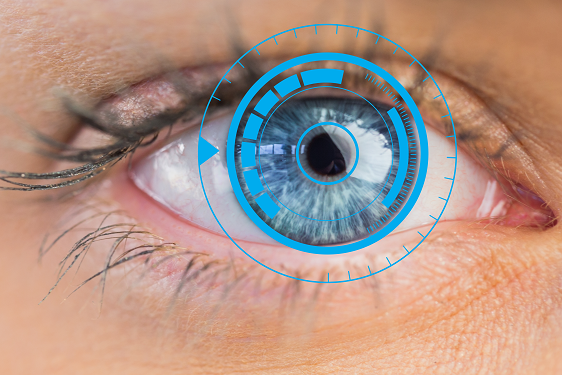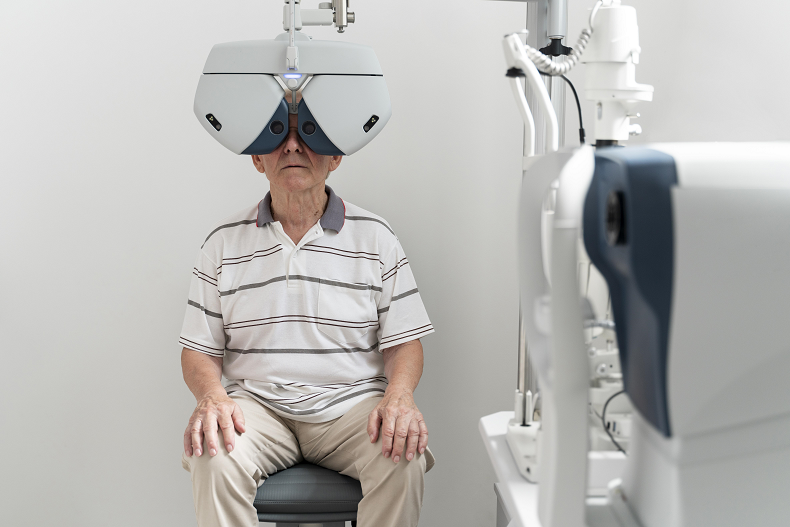Permanent Solution to See well Without Glasses After 40
Things you should know about TRIFOCAL and EDOF INTRA ocular SMART LENS application!
If you are over the age of 40 and are looking for a permanent solution to get rid of far and near glasses, you should definitely read this article, which will give you important information, without going into unnecessary details.
None of the laser treatments on the cornea can provide a permanent solution for those in this age group. With laser treatment, the number of distant glasses can be reset, but it cannot provide a solution for the near. After the age of 40-45, the refractive power of our own natural lens begins to change and the effect of the laser becomes ineffective. First of all, it is useful to give a very short information about visual defects.
We can simply divide vision defects into Myopia, Hyperopia and Astigmatism. If you have passed the age of 40, you can talk about the age-related near vision problem, which we call Presbyopia.
HYPERMETROPY (PLUS VALUE GLASS)
Those with hypermetropia can see far clearly without using glasses if their numbers are low at a young age, but after the age of 40 or even at an earlier age, they cannot see far and near without glasses because their eyes' ability to adapt decreases. Sometimes their tricks can progress quickly at this age and they become seriously dependent on using far and near glasses. From the moment they wake up in the morning, they have to wear glasses for basic functions such as shaving, applying make-up and even seeing the clock at the end of their head. These people are the group that suffers most from the use of glasses, and they form the patient portfolio that can benefit most from smart lens surgery.
MYOPY (MINUS VALUE GLASS)
People in this group cannot see the distance clearly without glasses, and when they take off their glasses, they can see up close more clearly. Normally, people with normal eyes at the age of 42-43 begin to need close glasses, but those with Myopia can do their close work until the age of 50-55 depending on their number.
ASTIGMATISM (CAN BE PLUS OR MINUS OR MIXED TYPE GLASS)
Astigmatism is a congenital deformity of the frontmost transparent layer of our eye (cornea). Astigmatists see both far and near blurry, they confuse the lines that come together, and they cannot see objects clearly and properly. It is possible to classify as Hyperopia, Myopia or mixed type Astigmsatism. Special astigmatism corrective Smart lenses are available for this group of patients.
PRESBYOPIA
With the advancing age, our natural lens gradually loses its ability to see up close, and because of this loss of adaptation between the ages of 40-43, people begin to need glasses for near and medium distance vision. As I mentioned above, while myopic people solve this problem by removing their distance glasses, those with normal eyes and hyperopia have to use close glasses. Generally, around the age of 43, it starts with +1.00 addition to their own eyeglasses number and progresses up to +2.50 to +3.00 addition until 55-60 years old.
TO WHOM AND WHEN CAN A SMART LENS BE APPLIED?
1-Hypermetropes are the most suitable patient group for this job. After the age of 43-45, this procedure can make them happy.
2- Although myopic patients differ according to retina and eye anatomy, they may become more suitable for this operation at a slightly older age, that is, after the age of 50-55.
3-For those with astigmatism, the above criteria are applied according to the hyperopia or myopic component.
4-Smart lens surgery due to some reasons is not recommended for those who do not have any glasses problems at a distance and only want to get rid of close glasses (except in some personal situations).
WHAT ARE GENERAL LENS OPTIONS?
• MONOFOCAL SINGLE FOCUS DISTANCE VISION
• PRIMIUM MONOFOCAL DISTANCE AND LOW MEDIUM VISION ie 60-65 cm
• EDOF FAR AND STRONG MEDIUM VISION ie 45-50 cm
• TRIFOCAL DISTANCE, MEDIUM AND VERY GOOD NEAR VIEW
WHAT DOES SMART LENS SURGERY PROMISE?
• THE AIM OF TRIFOCAL MULTI FOCUS SMART LENSES IS TO BRING THE PATIENT TO THE ABILITY TO SEE EVERYTHING WITHOUT GLASSES, AND TO REDUCE THE PERSON'S NEED FOR GLASSES BY 80-90%.
• EDOF SMART LENSES SHOW FAR AND MEDIUM DISTANCE BEAUTIFULLY, BUT THEY NEED A LOW NUMBER GLASSES SUCH AS +1.00, +1.25 FOR 30-35 CM DISTANCE NEAR. In order to make this even more glasses-free, it can target the non-dominant side of the weaker eye to -0.50 myopic and offer a near glasses-free field of vision to the patient.
• THERE IS NO CLAIM THAT WITH CURRENT TECHNOLOGY, THESE LENS WILL SHOW EVERY PLACE (FAR, NEAR AND MEDIUM DISTANCE) VERY CLEARLY!
• SOMETIMES A 0.25 OR 0.50 REMOTE GLASSES MAY BE REQUIRED TO SEE MORE CLEARLY, ESPECIALLY WHEN DRIVING AT NIGHT.
• SOME UNDESIRED VISIONAL EFFECTS (POSITIVE AND NEGATIVE DYPHOTOPSIA) MAY BE AT TIME TO SOME UNDESIRED VISUAL EFFECTS AS IT MAY NOT BE LIKE YOUR NATURAL LENS. (MOST OF THE TIME IT PASSES).
WHO SHOULD NOT HAVE TRIFOCAL LENS SURGERY?
- THOSE WHO HAVE ANY YELLOW SPOT DISEASE
- THOSE WHO HAVE UNCONTROLLED ADVANCED EYE TENSION DISEASE DIABETES RETINOPATHY
- ADVANCED DRY EYE PATIENTS
- THOSE WHO HAVE CORNEA DISEASE
- THOSE WHO HAVE AN EXTREMELY PERFECT PERSONALITY
- WORKERS IN NIGHT SPOT LIGHT ENVIRONMENTS
- THOSE WHO HAVE TO DRIVE HIGHLY AT NIGHT
- THOSE WHO DO WORK THAT REQUIRES VERY FINE DETAIL WITH THEIR EYES
- PILOTS
- PATIENTS THAT ARE NOT SUITABLE FOR THE TRIFOCAL FOCUSING MECHANISM OF THE ANATOMICAL PERSPECTIVE OF THE EYE
WHAT CAN BE DONE FOR THE ABOVE PATIENTS?
PRIMIUM MONOFOCAL OR EDOF lenses can be an alternative solution to Trifocal lenses for the people mentioned above. It is necessary to decide according to the specific situation of the patient.
CAN A SMART LENS BE INSTALLED FOR PEOPLE WHO HAVE LASIK (LASIK, PRK etc.)
Patients in this group should be treated more cautiously. Two issues are important in this regard:
1-Since the cornea has lost its natural shape, an error margin may occur in the diopter number calculation of the intraocular smart lens to be inserted to reset the number, resulting in a number deviation, which we call a residual.
2-EDOF lens option may be more suitable instead of Trifocal due to undesired aberrations in the eye as a result of laser, or none of them may be suitable. In order to solve these problems, it is possible to obtain good results by minimizing the margin of error thanks to precision measuring devices.
DO SMART LENSES HAVE SIDE EFFECTS?
In general, no serious visual side effects are observed after the appropriate lens model is attached to the appropriate patient.
However, some people may have individual sensitivities and it may not be possible to determine this exactly before the surgery.
Halo and glare (halo and glare) around lights at different levels during night vision, which can be seen especially in trifocal lenses and which we encounter more or less naturally in this type of lenses, is the most common complaint, we call it POSITIVE DYSPHOTOPSY. This complaint occurs much less or not at all with EDOF lenses. This phenomenon is partly related to personal light sensitivity and often begins to subside a few months after surgery.
Also, another visual phenomenon we call NEGATIVE DYPHOTOPSY can be seen in both trifocal and EDOF lenses. In this visual perception, shadows occur from time to time in the form of a half-moon on the outside of the eye, and patients say that they sometimes see shadows on the side. This phenomenon also decreases with time.
HOW MANY YEARS CAN SMART LENS GOVERN ME?
The lifetime of these lenses is estimated to be 200-250 years. Therefore, when your surgery is performed under suitable conditions, it will serve you until the end of your life.
WHAT IS OUR DIFFERENCE?
First of all, all your previous compliance tests and evaluation process are carried out by Dr Ferşat Muhacir, an expert ophthalmologist certified by the European Board of Ophthalmology, who has performed thousands of operations on this subject.
The evaluation and surgery devices used in our clinic are the latest technological precision measurement devices in the world, and we can minimize the measurement-related error margin to near zero.
The intraocular lenses used are the latest products of world-renowned companies such as Alcon, Zeiss, Johnson & Johnson and Rayner. The surgical procedure is performed by DR Ferşat Muhacir, who has more than 12000 surgical experience.
In other words, from the first time you enter the clinic, from all measurements and evaluations to the last control after the surgery, one-stop operations are carried out by Dr. Ferşat Muhacir, very meticulously for the individual, and we aim to reduce the risk of errors in measurements and procedures.


LAST WORD
Today, human beings have started to need close vision more and more frequently than in the past, especially with the increase in the use of mobile phones and social media.
Although the new generation smart lenses developed by medicine have tried to solve these problems to a large extent in the last 10 years, a few issues should not be overlooked:
1. Not all of these lenses are suitable for every patient. As a result of very detailed tests, deciding which lens is suitable for which patient is related to the reliability and quality of the measuring devices, in addition to the experience and knowledge of the physician.
2. All of these lenses are prostheses to make your life easier and to improve your quality of life. One should never expect a performance like one's own natural lens. There may be some restrictions from time to time. These should be considered normal.
3. If your eyes are not suitable for smart lens surgery as a result of the tests performed without compromising the ethical indication rules, we expect you to understand this. Remember, all these decisions are for your own good.
Habitat Health Centre brings you the most efficient treatments for your eye health by the hands and experience of its specialist fellows of the European Board of Ophtalmology and awarded by the European Board of Ophtalmology, using the most advanced state-of-the-art technology.
We think the measurement and its reading is the most important step of all treatments because it underpins most clinical decisions. It forms the basis of diagnosis, prognosis and evaluation of the results of medical intervention. Efficient, safe and accurate medical care is based on collection and interpretation of data.
We offer our treatments for eye diseases in two categories:
SMART LENS SURGERY
(prices range from 2.300 € to 2.750 € per eye, depending on the type of lens)
REFRACTIVE SURGERY by EXCIMER LASER
(prices range from 1.700 to 4.000 for both eyes, depending on the type of intervention)


| Here is some videos for your aesthetic treatments. You can also visit our aesthetic BLOG page. |
|
|
|